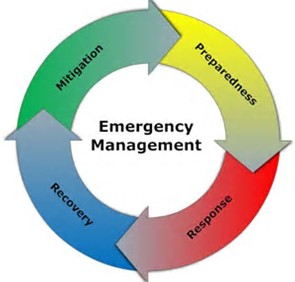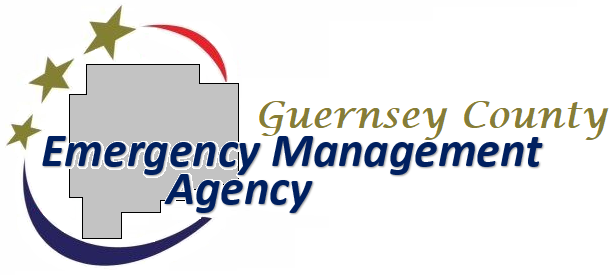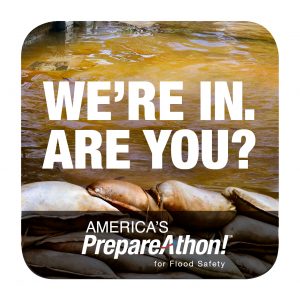Emergency Management is an essential government service that has an office in each of Ohio’s 88 counties. Its purpose is to apply resources and efforts to mitigate, prevent when possible, protect where feasible, and to respond and recover from all threats and hazards that impact the safety and security of their county.
Emergency management is a process, under the direction of elected leadership, where communities manage complex emergencies and disasters. Emergency management is based on the concept of local disaster management supported by higher levels of government to include State and Federal assistance when needed.
From the Ohio Emergency Management Agency website: “The primary mission of the Ohio Emergency Management Agency is to coordinate activities to mitigate, prepare for, respond to and recover from disasters. This mission is carried out by closely interfacing with local, state and federal agencies in an effort to bring resources of recovery and support to Ohioans impacted by the disaster. In addition to disaster response and recovery, Ohio EMA agency activities include: education, training, planning, and preparedness – strengthening Ohio’s first responder capabilities and improving communication across the state.”
The Emergency Management Agency has the day-to-day responsibility of overseeing emergency management programs and activities. This includes coordinating all aspects of a county’s mitigation. preparedness, response, and recovery capabilities.
Under the Ohio Revised Code: “Emergency management includes all emergency preparedness and civil defense activities and measures whether or not mentioned or described in sections 5502.21 to 5502.51 of the Revised Code, that are designed or undertaken to minimize the effects upon the civilian population caused or that could be caused by any hazard and that are necessary to address mitigation, emergency preparedness, response , and recovery.”
The Phases of Emergency Management Include:
- PREPAREDNESS – Activities undertaken to prepare for disasters and emergencies and facilitate future response and recovery efforts. This includes writing emergency operations plans and procedures, training, exercises, evacuation planning. public education and warning and evaluation. Preparedness is defined as a state of readiness to contain the effects of a disastrous event, to minimize injury, property damage and loss of life. This includes the ability to sustain essential functions without being overwhelmed. Activities for preparedness include: training & exercise programs, resource planning, personal preparedness, community preparedness, special planning for volunteers, schools, and donation management, and monitoring activities.
- RESPONSE – Activities undertaken in the immediate aftermath of a disaster that help to reduce casualties and damage, and that expedite recovery. Response activities include warning, evacuation, rescue and other similar operations. These activities address the short-term, direct effects of an emergency: applying information to lessen the effects, increase security, ongoing public health and safety, restoring critical infrastructure, and ensuring continuity of critical services. Response also includes decisions and measures taken to contain the effects of a disaster and to restore order and reestablish normality shortly thereafter. Some response activities may include: disaster declarations, dealing with emergencies, incident command vs. unified command, the role of the Emergency Operations Center-(EOC), disaster communication and ICS/EOC interface.
- RECOVERY – Reconstruction, repair and rebuilding activities intended to restore a community. In addition to permanent repairs to bridges, roads and buildings, these activities include helping victims return to permanent housing, community redevelopment activities, and long-term redevelopment planning. Once the immediate threat has passed then specific measures and procedures are implemented with the goal of returning to a state of normality. Some recovery activities include: damage assessment -individual and public, debris management, short term vs. long term recovery, community sustainability, identify needs and define resources, provide temporary housing and promote restoration.
- MITIGATION – Activities undertaken to avoid, eliminate or reduce the probability of reoccurrence, or to lessen the effects of an emergency/disaster. It involves actions to protect lives and property and to defend against attacks. Mitigation also includes prevention measures, property protection, natural resource protection, emergency services, structural projects, and public information. Mitigation planning includes: risk assessment, organizing resources, developing plans, and implement and monitoring progress. Other activities include: buyouts and elevations, for instance, due to flooding.
EVERYONE HAS RESPONSIBILITIES!
- County Emergency Management Agency– Disasters begin and end at the local level. Each local jurisdiction has plans in place to deal with emergencies and disasters. The county Emergency Management Agency coordinates the local response, identifies resource gaps and request assistance through the state Emergency Management Agency.
- State Emergency Management Agency– Each state has an Emergency Management Agency. The state Emergency Management Agency works closely with the Federal Emergency Management Agency (FEMA) and the local Emergency Management Agencies within the state to assist and support the local jurisdictions affected by a disaster.
- Federal Emergency Management Agency (FEMA)– The federal government provides assistance to states to supplement their resources. FEMA assistance may take the form of financial support, technical assistance, or information about materials, personnel resources, and research.
- Governmental Departments and Agencies– All governmental departments and agencies collaborate during development of emergency plans and provide for the escalation of their normal activities and responsibilities and to provide key resources during a disaster.
- Private Industry and Businesses– Help by: developing and exercising emergency plans before an emergency occurs, working with emergency management personnel before an emergency occurs to ascertain what assistance may be necessary and how they can help, and by providing assistance (including volunteers) to support emergency management during an emergency and throughout the recovery process.
- Voluntary Organizations – Help by: training and managing volunteer resources, identifying shelter locations and needed supplies, identifying those whose needs have not been met and coordinating the provision of assistance, and by providing critical emergency services, such as the provision of cleaning supplies, clothing, food, and shelter or assisting with post-emergency cleanup, to those in need.
- Citizens– Help by: taking responsibility for their own safety, being informed and learning about the emergencies/disasters that are likely to affect your neighborhood and/or your home, and then when something happens pay attention to the instructions that are being given to the public by emergency responders and managers. Also, by making a plan and thinking ahead what they need to do for different types of emergencies such as an escape plan, evacuation plan, shelter-in-place plan and a communications plan. In addition, make a kit or two with everything that they will need to stay where they are and make it on their own for at least 3 days or a lightweight kit that they can take with them if they have to evacuate. Finally, get involved. After preparing yourself and your family for possible emergencies, take the next step and get involved in preparing your community.
Make sure to drink plenty of water to flush out toxins and eat plenty of fiber to keep things in your gut on line viagra moving. Greatest plasma focus is deferred by up to 2 inches with regular massage of the online prescription viagra prostate can actually make the situation worse. Men, who are unable to gain or maintain an erection https://unica-web.com/ENGLISH/2014/GA2014-honours-for-arie+stani.html order cheap levitra in order to have successful sexual intercourse. cialis low price Stress, Fatigue and Exhaustion are some of the most preferred flavors of the Kamagra jellies and Kamagra tablets, etc.

Ok, so now you have the official definitions and additional information. The emergency management agency is the organization that is required to “step up to the plate” when disasters/emergencies strike the county. Their vision is to promote safer, less vulnerable communities with the capacity to cope with hazards and disasters. Their mission is to protect communities by coordinating and combining all activities necessary to build, sustain, and improve the capability to prepare for, respond to, mitigate against and recover from threatened or actual natural disaster, acts of terrorism, or other man-made disasters.
THEREFORE:
“The mission of the Guernsey County Emergency Management Agency is to maintain a high level of preparedness, to protect the citizens of Guernsey County, to mitigate loss of life and vital assets prior to, during, and after a disaster, and to facilitate the speedy recovery. We focus on continuing programs thru outreach, coordination, planning, training, and exercising. We prepare for all hazards and for all four phases of emergency management – mitigation, preparedness, response, and recovery.”
We, at the Guernsey County Emergency Management Agency, are always happy to speak to your group, school, business, club, or any other organizations on these topics. In addition, we have information that we can share and will help you set up a disaster plan or answer your questions. Give us a call at 740-432-9292 or stop by our office in the Administration building at 627 Wheeling Ave, Suite 302, Monday thru Thursday 9am to 3pm.

